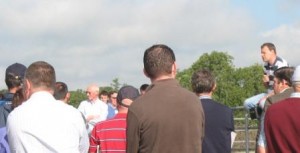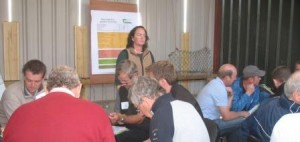Last week I attended the Dairy Business Expansion Conference near Kilkenny. I thought it was great! About 175 farmers, all clients, attended this Teagasc day-long event. It was actually a test of the method and topics. The week before, about 15 Teagasc dairy advisors (extension agents) met at the site with researchers to discuss how best to teach the topics on the day.
One of Ireland’s stated goals is to expand milk production by 50% in the year 2020 over the 2007’s production. The European Union’s dairy marketing quota ends on April 1, 2015. Dairy farming, on average, is the most profitable type of farming in Ireland. So, many dairy farmers are looking to expand, and non-dairy farmers are thinking about getting started. The point of the Conference was to get farmers thinking about and working on the nuts and bolts of a possible expansion.
The main topics for the day were: 1) Return on your investment; 2) Managing cash flow; and 3) Dealing with risk. Farmers were made up into groups of 15-10 people, and they stayed with their group for the day (which ran from 10 am to 3 pm).

Last minute preparations in front of the shed with calf pens. Note hay bales used as sound-deadeners in front of shed, there is an identical shed to the right of the bales.
The day began with a short welcome. Farmer groups moved into the calf sheds for a 1-hour session: Return on Investment. There was plenty of discussion as farmers figured how much a given farm would need to invest for a certain expansion. We found plenty of places to invest: soil fertility and reseeding; water, fencing, and roadways for grazing infrastructure; milking facilities; wintering facilities and manure storage; and cows and heifers. Next: how much of your own money do you put in versus how much to borrow? Would your bank lend you this kind of money? Do you need to invest that much? Our group had a good discussion on how much overrun to plan on. Experience at the Greenfield Farm shows at least 10% is a good figure. One farmer in our group said that any overrun shows poor budgeting and estimating! Then the groups worked on a partial budget to calculate potential profit from the additional cows, and compared that to the additional assets and equity put into the expansion to calculate a return on assets and return on investment. We were plenty busy for an hour!
Farmers headed outside to look at cows and pasture and hear about how the Greenfield Farm is doing compared to their plan of 3 years ago: budget versus actual. Then back into the sheds for Cash Flow work. The groups estimated milk income, and several of the important costs. They used 1 year of actual figures and estimated for the next 5 years. They had to estimate principal and interest payments, add up the columns and look at the Bottom Line. Which years were negative? How much? What could be done to either fix that or live with it?
Next- lunch! Then a look at how physical production of grass and cows are doing compared to the original plan, and in the very wet year last year and very dry summer of 2103. The last small group work was on Risk. Farmers brainstormed the risks involved with this expansion. Then picked 4 of the risks and thought about the likelihood of it happening, the impact of it happening, the cost if it happened, what the owner could do to minimize that risk or deal with the occurrence, how much would it cost to manage that risk, and what would be some early warning signs of a problem coming?
Farmers left with the worksheets they had filled out during the day and blank worksheets to work with for their own farm. They were directed to where some of these tools are located on the Teagasc Client website. The conference was full, and there may be a second one. The dairy advisors who ran the small groups now have better skills to work with their clients who are considering an expansion.
To me, the day was a big success: farmers were definitely discussing what capital improvements were needed, what they might cost, how to do it cheaper, talking about borrowing money, and really thinking about what risks an expanding dairy faces and what could be done about those risks.



